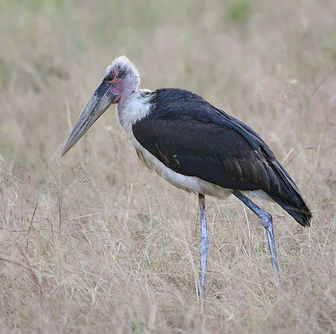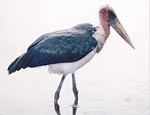Marabou Stork
A massive bird, large specimens are thought to reach a height of 150 cm , a weight of over 9 kg and have a wingspan of at least 3.5 m . In the last regard, it shares the distinction of having the largest wingspan of any landbird with the Andean Condor. More typically, these birds measure 120–140 cm , 310–350 cm across the wings, and weigh 6–10.5 kg . Unlike most storks, the three Leptoptilos species fly with the neck retracted like a heron.

Original source: Own work
Author: Muhammad Mahdi Karim FacebookThe making of this document was supported by Wikimedia CH.For all the files concerned, please see the category Supported by Wikimedia CH.
Permission: GNU Free Documentation License
Marabou stork - Beauty is not everything
 Marabou storks (Leptoptilos crumeniferus) really don't meet our ideal of beauty. Their large massive beaks, their naked necks and hardly feathered heads as well as their inflatable throats are all but attractive to us. Their appearance gave them a rather bad image, but human ideals fortunately are not the standard of nature. So Marabou storks are very successfully occupying an important role within their ecosystem.
Marabou storks (Leptoptilos crumeniferus) really don't meet our ideal of beauty. Their large massive beaks, their naked necks and hardly feathered heads as well as their inflatable throats are all but attractive to us. Their appearance gave them a rather bad image, but human ideals fortunately are not the standard of nature. So Marabou storks are very successfully occupying an important role within their ecosystem.
There are three species of Marabou storks
Speaking of "the" Marabou, one is thinking of the African Marabou stork. It inhabits the open and hot savannah regions and is still quite numerous. Obviously the Marabou is one of the characteristic animals of Africa. But there are also two Asian species, which resemble their African relative very much. Unfortunately those species have suffered a decrease in their numbers and are endangered nowadays. One ist the Greater adjutant (Leptotilos dubius), inhabiting Myanmar, Indochina and the Indian province of Assam. The other one is the Lesser adjutant (Leptotilos javanicus), a species with a similar distribution range, including the islands of Sumatra, Kalimantan, Java, Bali and Borneo.Marabou storks like human settlements
The (African) Marabou storks reach a wing span of 2,6 metres and a height of 1,5 metres. They fly in a majestic way and live mostly solitary or in small groups. Larger groups can be seen near sources of food, while migrating or during the breeding season. Marabous breed on the treetops, where they build large nests. Like our White stork (Ciconia ciconia) they like to be near human settlements. Marabou storks share another behaviour with the White stork: They clatter their beaks, a greeting ritual, which is mainly shown by partners at the nest. Additionally Marabou storks are able to give grunting and snoring sounds.Marabous help to keep their surroundings healthy
The Marabou storks' form of nutrition surely contributed to their bad image; they mainly feed on carrion and scraps. Although it doesn't seem to be very sympathic in human eyes, this behaviour is of great importance to the ecosystem they inhabit; by removing carcasses and rotting material, Marabous help avoiding the spreading of pathogenes.This article was originally published at magazine.naturspot.de. Link to the original article
The Marabou Stork is classified as Least Concern. Does not qualify for a more at risk category. Widespread and abundant taxa are included in this category.

Original source: Cacophony
Author: Cacophony
Permission: Some rights reserved
Family : Ciconiidae
Genus : Leptoptilos
Species : crumeniferus
Authority : (Lesson, 1831)

